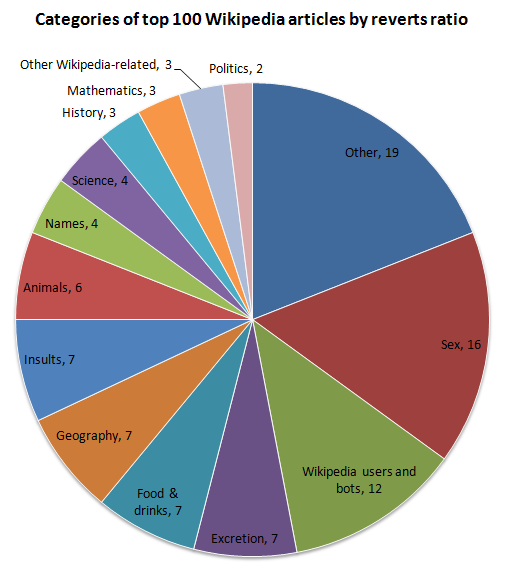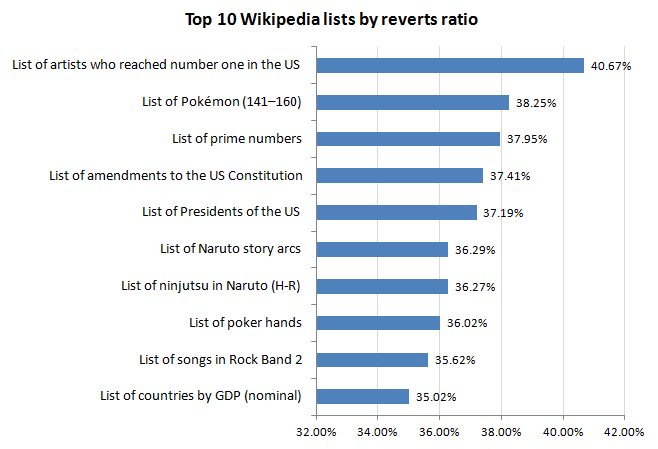On August 13, 2010, a database of the most reverted English Wikipedia pages has been released by Dmitry Chichkov on the Wiki-research mailing list. “Reverts ratio” (i.e. the ratio of invalidated changes to a certain article / the total number of revisions) is considered as a reliable indicator of vandalism in Wikipedia. (In case you wanted a piece of the action, here is the link to the list of the most reverted pages and here is the python script used to calculate it). A preliminary analysis performed by one of the administrators, Utkarshraj Atmaram, provides us with a good insight as to who vandals are.

Of course, the target pages fall in some predictable categories, like sex (16%), excrements (7%), and insults (7%). The kind of juvenile humor which would lead us into thinking that Wikipedia vandalism is circumscribed to teenagers and young adults. And the fact that the years 1986-1992 are the most “reverted” seems to corroborate that, too. True – as computer scientist Luca de Alfaro was quick to point out – among the main targets we find such articles as « Incas » or « Italian renaissance ». Hardly the object of toilet humour, these topics help us formulate the following hypothesis: vandals’ cultural interests converge on contents they happen to browse while trying to copy and paste stuff for their assignments/projects/essays. Consistently, there is a link between the rowdy behaviour of those 18-24 year-old Wikipedia users and a certain brand of school and academic socialization.
This brings us to another clear result: among all the English-speakers, the higest concentration of vandals (as far as their number is proportional to articles with higher reverts ratio) is among Northern American. users ‘America’ (distinctly considered as synonymous with the ‘US’) is the number 1 of the top ten most reverted countries (40.9%); 9 over 10 of the most reverted articles about battles touch on historical events that took place inside the US or Canada borders; some of the most targeted ‘talk pages’ are those of North-American celebrities (Zac Efron, the Jonas Brothers…) and historical figures (Benjamin Franklin, George Washington…).
So who are those Wikipedia vandals? Their sociological portrait is shaping up: they are young, aware of all things American and, well, quite geeky on the side. They browse through science and maths portals rather than humanities ones; they struggle over establishing lists of topics such as cartoons, video games, prime numbers, and so on.

How do we make sense of these results? The English Wikipedia article ‘Vandalism’ puts a lot of emphasis on Pierre Klossowski’s argument that vandalism might be regarded as a cultural guerilla of a sort against an oppressing intellectual hegemony. Vandals are, and I quote, “only the reverse side of a criminal culture”. Yet this notion of “reverse side” – though conceptually linked to that of “revert ratio” – does not only signify a dialectical opposite, but also a mirroring image of the general consensus that Wikipedia articles are built upon. In a sense, the vandals – as a group contributing in their own disruptive way to the social construction of knowledge in the popular online encyclopedia – can and must be considered as a reflection of the wikipedians as a whole.
Although I’m not aware of an updated English Wikipedia census, I’d like to make an educated guess that the cultural concerns, demographic composition and interests of those users who commit vandalism are not that dissimilar from those of their older brothers, the regular contributors. And by this I mean that vandalism do not represent an anti-culture fighting against a power elite of administrators and vigilante editors.
We can agree that Wikipedia, more than other encyclopedic projects, has “in-built reflection or reflexivity” (Rogers, 2009: 28) insofar as it shows that knowledge is not a collection of notions, but a process in the making. Several actors take part to this process and contribute, through negotiation, controversy, advocacy, and – it is my opinion – vandalism to this reflexivity. Undoubtly, the role of vandalism is usually overshadowed by pro-social behaviors. An average vandalist act stays unpunished (i.e. unreverted) for a little more than a minute and a half (Viégas et al., 2004). That is why we don’t appreciate the contribution of vandalism – because we don’t see it develop over time. That is why this list of most reverted articles has helped us see how vandalism builds up over topics, how it is structured, hence providing a useful portrayal of the cultural interests (and of the corresponding cultural biases) of the entire Wikipedia community.
REFERENCES
Viégas, Fernanda B., Wattenberg, Martin and Dave Kushal (2004) “Studying Cooperation and Conflict between Authors with History Flow Visualizations”, CHI 2004, 6 (1): 575–582.
Rogers, Richard (2009) The End of the Virtual: Digital Methods, Amsterdam: Amsterdam University Press.